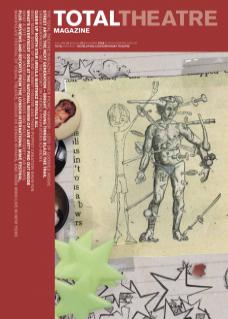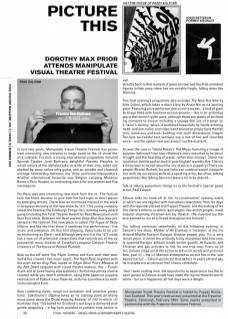In just two years, Manipulate Visual Theatre Festival has grown from interesting new initiative to major event on the UK visual theatre calendar. For 2009, a strong international programme included Spanish-Catalan Jordi Bettran’s delightful Poemes Visuales, in which letters of the alphabet take on a life of their own, aided and abetted by some rather nifty guitar, and an amiable and clownish onstage relationship between the three performer/manipulators. Another international favourite was Belgian company Mossoux Bonte’s Twin Houses, an enchanting dance for one woman and five mannequins.
Yet there was also interesting new work from the UK. The festival took the brave decision to give over the last night to short pieces by emerging artists. There was an enormous interest in the work-in-progress showing of the new show by 1927. This young company swept the board at the Edinburgh Fringe 2007, winning every award going (including the Total Theatre Award for Best Newcomer) with their first show, Between the Devil and the Deep Blue Sea, also presented at the festival. The new piece is called The Fugue of Pazzy Villycar, and like the first show it combines live performance / live music and animation. On this first showing, Pazzy looks to be just as enchanting as Devil – and although very much in the 1927 mode, has a new air of whimsical melancholia that reminds me of the experimental music-theatre of Canadian company Catalyst Theatre (creators of The House of Pootsie Plunket).
Also on the bill were The Paper Cinema and Kora with their wonderful live cinema / live music event, The Night Flyer, together with the even better King Pest, based on Edgar Allan Poe’s Masque of the Red Death (popular with visual theatre-makers, this – Punchdrunk and Al Seed having also tackled it). Both these pieces involve created-while-you-watch animation, using little papercut puppets, reminiscent of Pollock’s toy theatres, with live soundtrack by multi-instrumentalist Kora.
Also combining music, rough-cut animation and ‘primitive projections’, Sokobauno’s Daphne takes as its starting point an anonymous poem about the Clyde shipping disaster of 1883 in which 120 workmen died. This ballad for Scotland’s lost boys is delivered with gentle poignancy – a fog horn sounded in present time seems to call directly back to that moment of great sorrow; and the little animated figures in their peep-show box are suitably fragile, falling down like dominos.
This final evening’s programme also includes The New Not New by Ailie Cohen, which takes a short story by Anais Nin as its starting point. Featuring a live performer and an intricate set – a kind of giant birdcage filled with feminine accoutrements – this is an ambitious piece that doesn’t quite work, although there are plenty of enchanting moments to savour, including a Lepage-like use of a gown on a ‘tailor’s dummy’ which is animated beautifully by hands entering head- and arm-holes, and video/sand animation projections that fall onto numerous surfaces, building rich multidimensional images. The less successful text sections use a mix of live and recorded voice – and the spoken text just doesn’t cut the mustard.
As was the case in Tabola Rassa’s The Miser, featuring a troupe of puppets fashioned from taps (Molière’s story reworked to be about drought and the hoarding of water, rather than money). Clever manipulation, but the spoken text (in poor English) is pretty dire. There’s a discussion to be had about the use of voice in puppetry! There are people (Ronnie Burkett, for one) who can combine expert manipulation with the necessary skills as a speaking actor, but often, talking puppeteers (like talking dancers) leave a lot to be desired…
Talk of talking puppeteers brings us to the festival’s special guest artist, Paul Zaloom.
Zaloom talks his head off at the ‘in conversation’ opening event, in which we are regaled with marvellous anecdotes from his days with the legendary Bread and Puppet Theater, and the making of his film Dante’s Inferno, in which ‘apocalyptic live-action graphic novel [meets] charming Victorian-era toy theatre’. (Re-invented toy theatre seemed to run as a thread throughout the festival!)
The talking continues relentlessly on the following evening, in Zaloom’s live show, Mother of All Enemies, a ‘mutation’ of the traditional Middle Eastern Karagoz shadow puppet play. It’s a very clever piece, in which the wickedly funny storyteller tells how newly-queered Karagoz defeats Israeli border guards, Al Quaeda, and Christian anti-gay activists to find his one true love. Every so often, Zaloom steps out of the action to tell us (in words and pictures) how, post 9/11, the US Marines attempted to recruit him in the ‘war against terror’ – Zaloom points out that as he’s 55 years old and gay, he is maybe not an obvious first-choice candidate.
Had I seen nothing else, the opportunity to experience live the lunatic genius of Zaloom would have made the trip northwards worthwhile – but as it happened, all five days were a delight.

